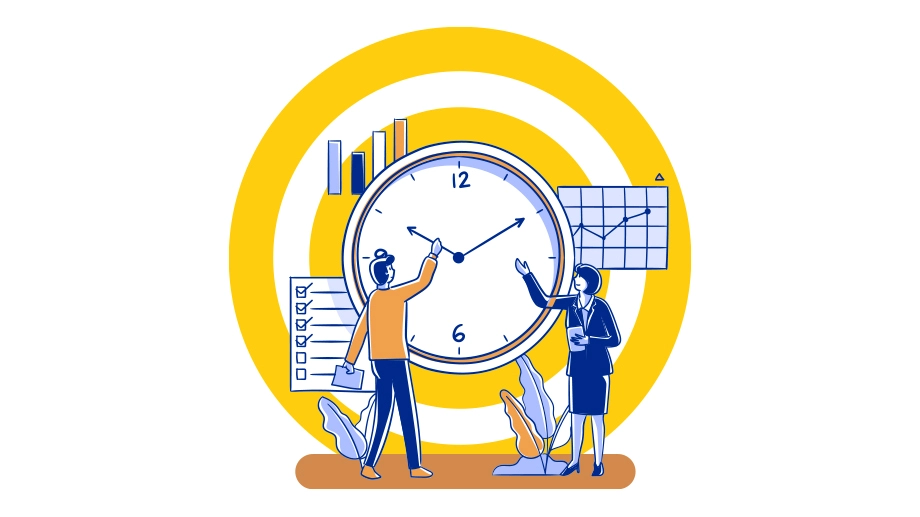Clocking in and out is a very important part of the workday. Not only is it important to keep track of your employee’s hours, but it also helps businesses manage their costs. Moreover, most companies with field team members prefer to use employee time tracking systems for record-keeping purposes since there are no physical ties between them and the workplace office.
One of the most crucial aspects when it comes to running a profitable business is knowing how much time your staff is spending on tasks and projects. According to a recent study, the average number of employees is productive only for 2 hours and 30 minutes per day. This is the basis for tracking the productivity of your staff and making sure they’re working efficiently.
A study conducted in 2020 showed that the US economy faces the loss of over 50 million hours per day due to non-recorded unproductive activities. The clock is ticking and if you don’t have a system in place for tracking employee hours and completing payroll accurately, it could cost you big money down the road.
Let’s walk through the reasons why time clocks for employees are important, and how to properly implement such a system in your business.
How to introduce employee time tracking in your organization
When you’re setting up a new time tracking system, it’s important to define how employees will clock in and out. Before you can start managing them, you need a process that everyone understands.
One way of accomplishing this is by adopting the advanced time management software used for clocking in and out. While skimming through the time tracking software options, you should consider things like shift hours, work location, task assignment, etc.
Finally, define how approvals will be handled: who makes these decisions? Does it happen via email chain or face-to-face meetings? And what happens if someone needs additional time off during their shift?
These details matter because they affect how quickly things move through your office once employees have finished working together—and whether your employees feel comfortable joining your team as well!
Benefits of Employee time tracking system
Time tracking and management are vital parts of any business. Time Tracking software can help you to get accurate and detailed data about your employees’ working hours so that you can properly manage them and make the most of their talents. The following are some benefits of implementing an employee time tracking system:
a) You will be able to track employees’ attendance on a day-to-day basis by creating an attendance log for each employee. This will help you in identifying potentially missed work days as well as in making sure that each employee has completed their tasks accordingly.
b) The complete set of records generated through the use of this type of tool can be used as evidence to support claims regarding overtime pay or other wages due.
c) This also makes it easier for employers who regularly employ large numbers of people over short periods than before when there were no effective tools available whatsoever that could accurately record how many hours worked by each employee over a given period!
d) It helps companies save money by reducing labor costs incurred because employees do not have time to take breaks during their working day. This means less time spent on coffee breaks, lunch breaks etc. which would otherwise cost businesses more money in the long run.
The best 5 practices to implement an employee time tracking system
Define the process for approving employee time entries.
- Define the process for approving employee time entries. Every business should have a written policy that outlines how and when employees should clock in and out, as well as which employees are responsible for ensuring proper documentation. This can be done through an electronic tool or a manual process, depending on your preference.
- Establish clear expectations on how often you’ll need to review your system’s data to ensure accuracy. You must establish clear expectations so that everyone involved understands what they need to do to stay on top of things—and avoid confusing other departments or employees who may not have been trained yet!
Hold employees accountable to your policies.
If you want to make sure your employees are following the rules, it’s important to hold them accountable. You can do this by making sure they know what the consequences of not following your policies will be.
If an employee is late or doesn’t clock out at all during his shift, he should be held accountable by being given a verbal warning. If this happens again after another warning will be issued and there are no extenuating circumstances involved, then you may want to consider taking some actions so that it doesn’t impact your business.
Automate as much as possible.
In a recent study by Deloitte, over 30% of employees indicated that manually entering payroll inputs and data adjustments are two of the most time-consuming processes. You can automate as much of your workplace as possible. Automation is key to efficiency, and it doesn’t have to be expensive or complicated.
Software automation tools like Geofencing based time & attendance systems allow employers (and employees) alike to clock in and out via smartphone apps. These programs keep track of employee hours per shift so that payroll administrators don’t have to worry about manually entering them into their systems each week.
A Geofenced-enabled time tracking system automates the clock-out process. For instance, once the employee enters/leaves the defined job location, the software detects and logs in working hours.
Track your data and optimize over time.
- Track your data and optimize over time
Whether you’re using a timeclock software, timesheet software, or both (or more), it’s important to track your data and make changes as needed. The goal of this process is twofold: firstly, to ensure that you’re getting accurate records of the hours worked by each employee; secondly, for the company itself to be able to see whether its employees are spending enough time on tasks related to their job descriptions or not.
- Use an hourly wage calculator if possible
This is a simple, yet powerful tool that can help you calculate the hourly wage for each employee. A good hourly wage calculator will also let you know whether your employees are being paid above or below market value for their positions. This knowledge can be useful when it comes to making decisions about salary increases and promotions.
Field service companies often have to deal with differing wage rates based on overtime pay, shift-differential pay and other criteria. A sophisticated wage calculator that factors in all these scenarios can be of great help not only for payroll teams but also for job costing teams.
Consistency is key.
You should be consistent with your company policies and processes, as well as how you track employee hours. It helps employees understand the rules and expectations for clock-in/out times, which in turn helps them comply with these rules better. This also makes it easier for managers to track employee performance over time, which leads to more accurate scheduling decisions (and fewer complaints).
Conclusion
The clock in and out process is a critical part of your business. With the right tool, clocking in and out at work is made easy and soon becomes second nature to your business.
The online timesheet data you capture from this process will allow you to spot trends and help drive performance in your business. By following these best practices, you can ensure that your employees are logged into their time tracker correctly and are accurately recording their time at work.
Your business is unique. You need a time tracking software that’s powerful enough and flexible enough to use so that when the issues arise, you can tweak it to make it work the way your business functions. Try the best time clock system for your business today.



